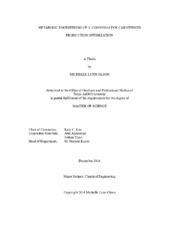| dc.description.abstract | Isoprenoids are naturally produced compounds in the budding yeast Saccharomyces cerevisiae. They are involved in essential cellular functions of the cell and are also further synthesized into pharmaceuticals, carotenoids, and biofuel alternatives. S. cerevisiae is a key model eukaryotic organism because it is both tractable and a nonpathogenic GRAS organism (Generally Recognized As Safe). S. cerevisiae is used extensively in metabolic engineering due to its well-curated and annotated genome and the wide range of tools available for genetic modifications. Engineering S. cerevisiae for production of heterologous isoprenoid compounds is a sustainable and cost effective alternate to production via chemical synthesis. β-carotene, an abundant isoprenoid compound in nature, protects cells from oxidative stress and reactive oxidative species in the environment. Through a novel adaptive evolution experiment of S. cerevisiae with oxidative stress as the driving force, we obtained a carotenoid hyper-producer strain that is able to produce 18 ± 1 mg/g [dry cell weight] β-carotene in 3 ml cultures. To test the potential for scale-up β-carotene production in yeast, we fermented the cultures in a 7L bioreactor. Optimization of the bioreactor parameters revealed the influence of media composition, aeration, and pH on β-carotene production.
We aimed to further optimize β-carotene production in S. cerevisiae with genetic and metabolic engineering. We reintroduced the cytosolic catalase T (CTT1) gene and overexpressed the known bottleneck of the isoprenoid biosynthesis pathway, HMG1. The reintroduction of CTT1 into SM14 (carotenoid hyper-producer) demonstrated improvement in carotenoid production, where production increased from 15 ± 3.3 mg/g [dry cell weight] to 22 ± 2.1 mg/g [dry cell weight]. The overexpression of truncated HMG1 in SM14, on the other hand, did not increase β-carotene production. The isoprenoid pathway is of a very complex phenotype and there are many direct and indirect variables involved in pathway performance. Even with these modifications to the hyper-producer strain, there seems to be limitations on β-carotene production. Further studies currently under investigation to increase β-carotene production include utilizing the fatty acid β-oxidation pathway for increasing the fatty acid content of the cell. | en |


